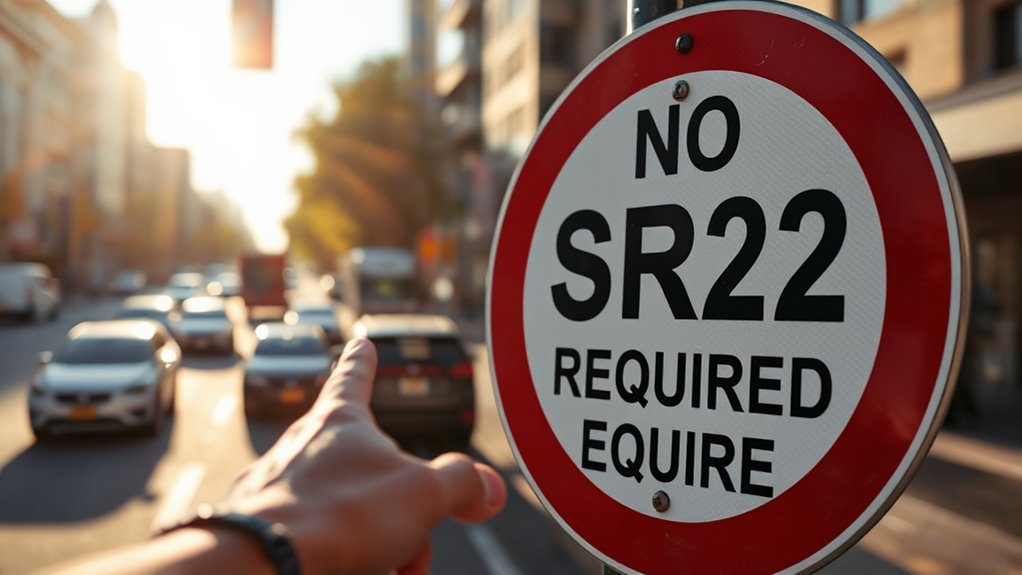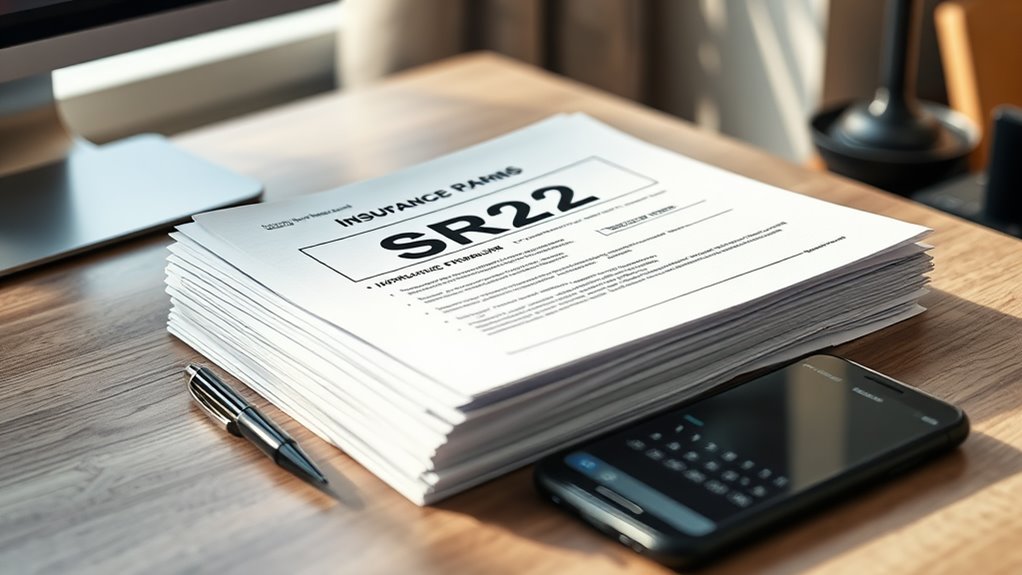
Think of SR-22 insurance as a lifeline for high-risk drivers in Ohio. If you’ve faced violations like DUIs or multiple traffic offenses, you might need this certificate to prove your financial responsibility. It’s essential to understand the implications, costs, and requirements involved. Ignoring these details could lead to serious consequences. So, what exactly does maintaining an SR-22 entail, and how can you effectively manage the associated costs?
Key Takeaways
- SR-22 is a certificate proving financial responsibility for high-risk drivers in Ohio, not traditional insurance.
- Common reasons for needing SR-22 in Ohio include DUI convictions and multiple traffic violations.
- SR-22 filing fees range from $15 to $65, with average annual costs around $662 for insurance premiums.
- SR-22 requirements typically last three to five years, depending on the severity of the offense.
- Compliance with Ohio’s minimum liability coverage is essential to avoid penalties and license suspension.
What Is SR-22 Insurance?

While many people think of insurance as a personal policy, SR-22 insurance is actually a state-required filing that proves you have the minimum liability coverage mandated by law.
It’s not an insurance policy you purchase; rather, your insurer files it directly with the state DMV on your behalf. Typically required after violations like DUIs or driving without insurance, this certificate serves as proof of financial responsibility for high-risk drivers. It helps reinstate your driving privileges following a license suspension and guarantees compliance with auto insurance laws. Maintaining continuous coverage is vital, as any lapse triggers a notification to the state, which can lead to further penalties or extended requirements. Additionally, the filing duration for maintaining SR-22 insurance is usually set at three years, depending on state regulations.
Reasons for Needing SR-22 in Ohio
You might need SR-22 insurance in Ohio for several reasons, including DUI/DWI convictions and multiple traffic violations.
If you’ve faced issues like unpaid child support or have accumulated serious driving offenses, the state requires this proof of financial responsibility. Drivers with moving violations for serious infractions can also find themselves needing to obtain an SR-22 to maintain their driving privileges.
Understanding these factors can help you navigate the requirements effectively.
DUI/DWI Convictions
A DUI or DWI conviction in Ohio triggers the mandatory need for an SR-22, which serves as proof of financial responsibility and guarantees compliance with state laws.
Here are some key points to reflect upon:
- Proof of Liability: The SR-22 shows you’ve got the minimum liability insurance required by Ohio law.
- Increased Insurance Rates: Convictions greatly hike your insurance premiums due to perceived risk.
- Reinstatement Requirement: You must file an SR-22 to reinstate your driving privileges after a suspension.
- Duration of SR-22: Typically, you’ll need it for three years, but severe offenses may extend this to five years.
Understanding these factors can help you navigate the consequences of your conviction more effectively.
Multiple Traffic Violations
Accumulating multiple traffic violations in Ohio can quickly lead to the requirement for an SR-22, as the state views these infractions as signs of risky driving behavior. Serious moving violations, like speeding or running red lights, contribute to this situation.
If you accumulate enough violations, the Ohio BMV will notify you about the need for an SR-22 to restore your driving privileges. This form serves as proof of financial responsibility, ensuring you can cover damages in case of an accident.
Additionally, further violations during the SR-22 period may raise your insurance premiums. To comply, you may need to adjust your existing coverage and work with high-risk insurers who specialize in these filings.
Child Support Issues
When unpaid child support leads to a suspended license in Ohio, the state may require drivers to file an SR-22. This filing serves as proof of financial responsibility and is vital for reinstating your license. Here are some key points to reflect on:
- License Suspension: The Ohio BMV suspends licenses for non-compliance with child support orders.
- Minimum Coverage: An SR-22 requires a minimum liability coverage of 25/50/25.
- Continuous Insurance: You must maintain active insurance throughout the SR-22 period, typically three years.
- Legal Consequences: Driving without a valid SR-22 can lead to further suspensions and legal penalties.
Complying with both child support and SR-22 requirements is essential for regaining your driving privileges.
Costs Associated With SR-22
When you need an SR-22 in Ohio, be prepared for increased insurance premiums alongside filing fees.
The filing fee typically ranges from $15 to $65, but the average annual cost for minimum coverage jumps to about $662.
Understanding these costs is essential for budgeting your insurance expenses effectively.
Premium Increases Overview
Although SR-22 insurance is essential for drivers in Ohio with certain violations, it often comes with considerably higher premiums. Several factors contribute to these increases, including:
- Risk Perception: Insurers view SR-22 drivers as higher risk.
- Type of Violation: Serious offenses, like DUIs, lead to significant hikes.
- Driving Records: A history of multiple violations results in elevated rates.
- Market Variability: Premiums can differ substantially among providers, sometimes by over $1,800 annually.
On average, SR-22 insurance in Ohio costs around $1,703 per year. For those with DUIs, monthly rates can reach approximately $103, far exceeding standard rates.
Understanding these factors can help you navigate the financial implications of SR-22 requirements.
Filing Fees Explained
Filing SR-22 paperwork incurs several costs that drivers in Ohio should be aware of. The Ohio BMV charges an average fee of $25 for processing SR-22 forms. Additionally, your insurance provider may charge $15 to $25 per filing, separate from your premiums.
While fees can vary by insurer, they typically remain low compared to the potential premium increases.
If you’re facing license reinstatement, expect fees ranging from $15 to $600, depending on your violation’s severity, payable before you can get your license back.
Be mindful of possible administrative costs for insurance documentation and the risks of late submissions, which can lead to extended suspensions and additional expenses. Staying compliant helps avoid further financial penalties.
Duration of SR-22 Requirements
In Ohio, the duration of SR-22 requirements typically spans from three to five years, depending on the severity of the offense that necessitated the filing.
Here are some key points to take into account:
- Minimum Duration: Most drivers will need SR-22 for at least three years.
- Maximum Duration: In cases of serious offenses or violations during the SR-22 period, it can extend to five years.
- Continuous Coverage: Any lapse in coverage can lead to penalties and an extended SR-22 requirement.
- Mandatory Filing: SR-22 must be filed with the Ohio BMV to demonstrate financial responsibility.
Understanding these factors can help you navigate the SR-22 process more effectively and maintain your driving privileges.
Types of Coverage for SR-22 Holders

When you need to meet SR-22 requirements in Ohio, understanding the different types of coverage available is crucial. There are several options to take into account.
An Owner SR-22 is for drivers who own a vehicle and need to comply with SR-22 mandates. If you don’t own a car, a Non-owner SR-22 covers you when renting or borrowing vehicles.
For those operating commercial vehicles, an Operator SR-22 is typically necessary. Businesses managing multiple vehicles may require a Fleet SR-22 to guarantee compliance.
How to Obtain an SR-22 in Ohio
To obtain an SR-22 in Ohio, you’ll first need to choose an insurance provider that can issue the necessary certificate.
After selecting your insurer, complete the application process to secure coverage and request the SR-22 form.
Finally, your insurer will file the SR-22 with the Ohio Bureau of Motor Vehicles (BMV) on your behalf.
Choose an Insurer
Choosing the right insurer for your SR-22 in Ohio is essential, especially since it’s not traditional insurance but a certificate demonstrating financial responsibility for high-risk drivers.
To help you make the best choice, consider the following factors:
- Cost Variability: SR-22 rates can differ widely between providers based on your specific violation.
- Specialization: Look for agencies that specialize in SR-22 filings, like 1st Choice Insurance, for better support.
- Provider Reputation: Choose reputable insurers like Geico or Auto-Owners known for their affordable rates and reliable service.
- Community Focus: Family-owned agencies often provide personalized customer service and a commitment to community involvement.
Complete Application Process
After selecting the right insurer for your SR-22 in Ohio, the next step is completing the application process.
First, confirm your insurer can file an SR-22 and request submission confirmation to guarantee proper documentation with the BMV. If your current provider doesn’t offer SR-22 services, look for specialists in high-risk insurance.
Be certain to compare filing costs, typically ranging from $20 to $50. Verify your policy meets Ohio’s minimum liability limits and maintain continuous coverage to avoid re-filing.
Settle any outstanding fines and pay the BMV reinstatement fee separately. Finally, submit your SR-22 electronically and monitor your reinstatement status through the BMV’s online services to stay compliant throughout the required year.
File With BMV
When you need to obtain an SR-22 in Ohio, the first step is ensuring your insurance provider can file the form on your behalf. Here’s how to navigate the process:
- Contact Your Insurer: Verify if they can electronically file the SR-22 with the Ohio BMV.
- Understand the Duration: Know that you’ll need to maintain the SR-22 for one to three years, depending on your situation.
- Stay Compliant: Keep your insurance active; failure to do so can lead to further suspension of your driving privileges.
- Pay Reinstatement Fees: Be prepared to pay any required fees to restore your driving privileges once the SR-22 is filed.
Following these steps will help you manage your SR-22 requirements effectively.
Insurance Providers Offering SR-22 in Ohio
Steering through SR-22 insurance in Ohio can be straightforward with the right providers at your side.
Geico offers competitive rates, charging just $44/month for liability after major violations. For minor infractions, Auto-Owners leads with rates starting at $34/month.
Military personnel can benefit from USAA’s full-coverage SR-22 quotes beginning at $127/month. Progressive provides flexible payment plans, charging $69/month for liability and up to $200/month for full coverage.
The General specializes in high-risk drivers, offering free online quotes without credit checks.
Whether you need minimum liability or full coverage, these providers deliver various options tailored to your needs and violation history. Always compare quotes to guarantee you get the best deal.
Compliance With State Regulations

Maneuvering the requirements for SR-22 insurance in Ohio involves understanding state regulations that govern financial responsibility for high-risk drivers.
To stay compliant, you need to be aware of the following key points:
Understanding the key points of SR-22 insurance is crucial for compliance in Ohio.
- Minimum Liability Coverage: You must maintain at least $25,000 for bodily injury per person, $50,000 per accident, and $25,000 for property damage.
- Duration: Keep your SR-22 active for a minimum of three years.
- Filing Process: Most SR-22 forms are filed electronically by your insurance provider.
- Notification to BMV: Your insurer will alert the Bureau of Motor Vehicles (BMV) if your policy lapses.
Consequences of Non-Compliance
Failing to comply with SR-22 insurance requirements in Ohio can lead to serious consequences that affect both your driving privileges and financial situation.
Your driver’s license may be suspended immediately, with the length depending on your offense history. For a first offense, you’ll face suspension until you file your SR-22 and pay the necessary fees. Repeat offenses can result in longer suspensions.
Financially, you’ll incur reinstatement fees and higher premiums for SR-22 insurance. Driving during suspension is a major violation that could lead to fines and court appearances.
Additionally, your vehicle registration may be suspended, and you risk impoundment if caught driving. Ultimately, non-compliance can complicate future insurance coverage and employment opportunities.
Tips for Managing SR-22 Insurance Costs
While managing SR-22 insurance costs can feel overwhelming, there are effective strategies you can employ to keep your expenses in check.
Managing SR-22 insurance costs may seem daunting, but there are effective strategies to help control your expenses.
Here are some tips to evaluate:
- Select Necessary Coverage: Stick to what’s required by Ohio law to avoid extra costs.
- Compare Quotes: Gather quotes from multiple providers to find the best rates.
- Inquire About Discounts: Look for good driver discounts or bundling options for savings.
- Maintain a Clean Driving Record: Avoid violations to stabilize and potentially lower your premiums.
Frequently Asked Questions
Can I Cancel My SR-22 Insurance Before the Requirement Ends?
You can cancel your SR-22 insurance before the requirement ends, but it may lead to license suspension and reinstatement fees. Make certain you understand state regulations and seek approval to avoid penalties.
Will My SR-22 Affect My Credit Score?
Imagine a storm cloud looming over your finances; while SR-22 itself won’t darken your credit score, high premiums could lead to missed payments. Stay vigilant, manage your budget, and protect your financial sunshine.
Can I Drive Out of State With an SR-22?
Yes, you can drive out of state with an SR-22, as long as your coverage remains active. Just make certain you comply with the original state’s requirements to avoid potential legal issues or penalties.
Can My SR-22 Be Filed Electronically?
Yes, your SR-22 can be filed electronically. Insurance companies often streamline the process, submitting the form quickly to the appropriate authority. This speeds up your reinstatement, so you can hit the road sooner.
What Happens if I Move to Another State With an SR-22?
If you move to another state with an SR-22, you must maintain coverage and notify the new state’s DMV. Your original state’s requirements still apply, and you might need to adjust your insurance policy accordingly.
Conclusion
Maneuvering SR-22 insurance in Ohio can feel like a modern-day labyrinth, but you don’t have to face it alone. By understanding your requirements and exploring options, you can emerge on the other side with greater financial responsibility. Remember, maintaining compliance is key to avoiding penalties and keeping your driving privileges intact. Stay proactive, shop around for the best rates, and keep your coverage continuous, ensuring you stay on the right side of the law.

When searching for non-owner SR-22 insurance, it's essential to evaluate various providers that cater to high-risk drivers. Each option offers different advantages, from affordability to all-encompassing coverage. Understanding the strengths and weaknesses of top companies like State Farm, GEICO, and others can help you make an informed decision. As you weigh your choices, reflect on how each provider aligns with your specific needs and circumstances. What factors will ultimately guide your selection?
Key Takeaways
- State Farm offers competitive non-owner SR-22 insurance with average premiums around $158 and high customer satisfaction.
- GEICO provides affordable liability coverage for non-vehicle owners with an average annual cost of $421, including SR-22 filings.
- The General simplifies obtaining non-owner SR-22 policies for high-risk drivers, maintaining transparency with included SR-22 filing fees.
- Dairyland Insurance has an A+ rating and offers reliable non-owner SR-22 policies with essential coverage and a streamlined filing process.
- Progressive efficiently files SR-22 forms for clients, providing immediate coverage and important support for maintaining SR22 status.
State Farm

When you're looking for non-owner SR-22 insurance, State Farm stands out as a solid choice due to its thorough coverage options and competitive pricing.
This type of insurance caters to drivers without a vehicle, offering liability coverage that meets state minimum requirements. It's especially beneficial for those facing SR-22 mandates following serious offenses like DUIs. State Farm's non-owner SR-22 insurance serves as proof of financial responsibility, which is crucial for license reinstatement after suspension. In Ohio, obtaining an SR-22 is often necessary for drivers who have had their licenses suspended due to serious offenses.
State Farm's monthly premiums average around $158, making them competitive in the market. While there's typically a small filing fee, the overall cost is often lower than many competitors.
Customer satisfaction is high, thanks to reliable support and accessible policies. However, keep in mind that comprehensive or collision coverage isn't included, which may affect your decision.
GEICO
For those seeking non-owner SR-22 insurance, GEICO emerges as a prominent option, providing liability coverage tailored for individuals without a vehicle. GEICO's policies focus primarily on liability for bodily injury and property damage, ensuring financial responsibility after serious driving offenses.
The average annual cost is around $421, often more affordable than traditional auto insurance. GEICO also handles SR-22 filings, making the process seamless. Coverage options include personal injury protection and rental car liability, catering to diverse needs.
However, note that policies don't cover damage to borrowed vehicles and act as secondary coverage. With competitive pricing and a strong market presence, GEICO is a reliable choice for non-owner SR-22 insurance.
The General
Although steering through the complexities of SR-22 insurance can be intimidating for high-risk drivers, The General simplifies the process with its tailored non-owner SR-22 policies.
Their service includes the SR-22 filing fee within the quoted insurance premium, ensuring transparency. You can quickly obtain the SR-22 form alongside your policy documents when purchasing online, streamlining compliance.
While premiums may rise due to prior infractions, non-owner SR-22 insurance typically costs less than owner policies since it doesn't insure a vehicle directly.
The General caters to most states, providing options for additional coverage and maintaining customer support for any inquiries.
This focus on affordability and specialized service makes them a reliable choice for managing SR-22 requirements.
Dairyland Insurance

Dairyland Insurance stands out as a reliable provider for non-owner SR-22 policies, complementing options like those from The General. With an A+ rating from AM Best, you'll benefit from their strong financial backing. Dairyland is licensed in 38 states, making it a viable choice for many.
Their non-owner SR-22 policies offer flexibility, allowing you to tailor coverage to meet your needs and budget. They provide essential coverage types, including liability and uninsured motorist options, and the filing process is streamlined with electronic submissions.
Additionally, Dairyland's mobile app enhances policy management, offering easy access to support, claims assistance, and payment scheduling. Overall, Dairyland combines affordability with extensive coverage to meet your SR-22 requirements effectively.
Progressive
When it comes to non-owner SR-22 insurance, Progressive offers an extensive solution tailored for high-risk drivers. They efficiently file the SR22 form on your behalf, ensuring compliance with state requirements.
The SR22 filing fee, around $25, is included in your overall policy cost. If you've had a DUI, Progressive provides immediate coverage and filing, helping you navigate the complexities of high-risk insurance.
Maintaining your SR22 status is essential; you must keep up with premium payments to avoid lapses. Progressive also notifies the DMV if your policy is canceled.
Maintaining your SR22 status is crucial; timely premium payments prevent lapses and ensure compliance with state regulations.
With competitive rates and a streamlined filing process, choosing Progressive can simplify your SR22 experience while adhering to state regulations.
Nationwide
Nationwide provides a thorough option for non-owner SR-22 insurance, catering to drivers with varied needs across the United States. They file SR-22 forms with DMVs on your behalf, an essential service if you face serious traffic violations or need to reinstate your license.
Coverage extends to non-owner policies, ensuring flexibility for out-of-state drivers. Their mobile app streamlines account management and claims filing, enhancing customer experience.
With strong financial ratings, including an A- from AM Best, you can trust their ability to meet obligations. Additionally, their personalized service through local agents balances national reach with local insight, making Nationwide a competitive choice in the SR-22 market.
Travelers

Although maneuvering SR22 insurance can feel overwhelming, Travelers Insurance offers a streamlined approach that simplifies the process for drivers in need of coverage. They integrate SR22 coverage with your existing policy, making management easier.
Here are some key benefits:
- Expert Guidance: You'll receive support to navigate state-specific requirements.
- Competitive Pricing: Enjoy cost-effective options without sacrificing coverage.
- Compliance Assurance: Travelers guarantees you meet all SR22 obligations effectively.
With a commitment to customer resources, Travelers helps you assess your current policy and maintain compliance.
Their holistic strategy allows for policy customization and financial flexibility, giving you peace of mind as you shift towards standard insurance once your SR22 period ends.
Conclusion
Choosing the right non-owner SR-22 insurance provider can seem intimidating, especially with numerous options available. However, by evaluating the strengths of companies like State Farm and GEICO, you can find coverage that meets your needs without compromising on quality. While cost is often a concern, remember that investing in reliable insurance now can save you from greater expenses later due to potential claims or penalties. Prioritize your peace of mind and guarantee you're compliant with the law.

Many people hold misconceptions about insurance, particularly regarding terms like SR22. This certificate of financial responsibility often confuses drivers, leading to misunderstandings about its implications and requirements. It's essential to grasp the nuances of SR22 and how it fits into the broader landscape of insurance. By clarifying these points, you can make more informed decisions about your coverage and avoid potential pitfalls. Let's explore key insights to enhance your understanding.
Key Takeaways
- Clarify that SR22 is not a type of insurance, but a certificate proving financial responsibility after serious offenses.
- Emphasize that increased insurance rates stem from violations, not the SR22 filing itself.
- Educate about the duration of SR22 requirements, typically lasting three years after a first DUI offense.
- Highlight the importance of maintaining continuous coverage to avoid license suspension and ensure compliance.
- Encourage shopping around for insurance to manage costs effectively, as rates vary by provider and location.
Understanding What SR22 Insurance Really Is

While many drivers may associate SR-22 insurance solely with penalties, it's essential to understand that it serves an important function in maintaining compliance with state vehicle insurance requirements.
An SR-22 is a document proving you meet these requirements, often needed after serious traffic offenses like DUI or DWI. It demonstrates your financial responsibility by showing that you have the minimum liability insurance mandated by your state. Additionally, the SR-22 is filed by insurance companies with the state on your behalf to validate your insurance coverage. In Ohio, an SR-22 is specifically required for certain traffic violations that indicate a higher risk to public safety.
An SR-22 is essential for proving financial responsibility after serious traffic offenses, ensuring compliance with state insurance requirements.
If you've faced a license suspension or have been involved in an accident without insurance, you might also need one. Keep in mind that the duration varies, typically lasting three years, and continuous coverage is important.
Failing to maintain compliance could lead to further penalties, including license suspension.
SR22 Insurance Is Not a Type of Insurance
Many drivers mistakenly believe that SR22 insurance is a distinct type of insurance policy. In reality, it's a certificate of financial responsibility required by certain states. This certificate proves that you meet the minimum liability insurance limits mandated by law.
The filing process involves your insurer submitting the SR22 form to the state, confirming you have adequate coverage. Misconceptions arise due to the specialized term "SR22 insurance", which implies a separate policy.
Additionally, drivers often associate SR22 with serious infractions like DUIs, further complicating understanding. Remember, SR22 doesn't alter your existing insurance but adds a filing requirement, so it's essential to grasp its true nature to avoid confusion and guarantee compliance with your state's regulations.
SR22 Filing Does Not Increase Your Insurance Rates
SR22 filing often gets the blame for increased insurance rates, but this assumption overlooks the true source of the cost hike.
The SR22 itself is a form that merely certifies your financial responsibility after a serious violation, such as a DUI or at-fault accident. It's the underlying violation that increases your insurance premiums, not the filing.
Insurance providers view those violations as indicators of higher risk, leading to elevated rates. Additionally, factors like location and the specific insurance provider's policies also play significant roles.
You Don't Need an SR22 for Every Traffic Violation

Do you really need an SR22 for every traffic violation? The short answer is no.
SR22 forms are specifically required for serious offenses, such as DUIs or reckless driving, serving as proof of financial responsibility. Minor infractions, like parking tickets or minor speeding violations, don't necessitate an SR22.
It's crucial to understand that SR22 requirements vary by state, and most states mandate it only under serious circumstances. Maintaining valid insurance and avoiding severe offenses can help you steer clear of unnecessary SR22 filings.
If you face legal issues, addressing them promptly with potential attorney representation may mitigate the need for an SR22, ensuring you keep your driving privileges intact without additional complications.
SR22 Insurance Is Not Permanent
While it might feel like an SR22 requirement is a permanent mark on your driving record, it's actually only a temporary measure mandated by the state following specific infractions.
Typically, you'll need to maintain an SR22 for about three years after a first DUI offense, but this duration can extend if you have additional violations or serious infractions like reckless driving.
Maintaining an SR22 is typically required for three years after a first DUI, with possible extensions for further violations.
To keep your driving privileges, you must guarantee consistent payment of premiums and timely policy renewals; any lapse can lead to a suspended license.
Remember, while the costs can be intimidating, shopping around can help manage the expense.
Ultimately, adhering to SR22 requirements is essential for regaining full driving rights and improving your insurance rates over time.
SR22 Coverage Is Specific to Ohio Laws
Understanding that SR22 coverage is specific to Ohio laws is important for drivers facing certain legal challenges.
In Ohio, SR22 insurance acts as proof of financial responsibility, especially after serious offenses like DUIs or reckless driving. The Ohio Bureau of Motor Vehicles (BMV) requires insurers to file the SR22 certificate to confirm you meet minimum liability coverage. This filing is essential for regaining or retaining your driving privileges.
If you've been convicted of driving without valid insurance or have accumulated multiple traffic violations, you'll likely need SR22 coverage.
You Can Still Get Insurance With an SR22 Filing

How can you navigate the challenges of obtaining insurance with an SR22 filing? While it may seem intimidating, securing coverage is possible. Here are some key points to evaluate:
- Understand SR22: It's a certificate proving you meet minimum insurance requirements, not insurance itself.
- Explore Options: Non-owner SR22 policies exist, allowing flexibility if you don't own a vehicle.
- Be Prepared for Higher Premiums: Expect increased costs due to the perception of higher risk.
- Stay Compliant: Keeping continuous coverage is essential to avoid penalties and maintain your driving privileges.
Conclusion
Maneuvering the world of insurance can feel like wandering through a dense forest. By understanding the true nature of SR22 and addressing common misconceptions, you're equipping yourself with a compass to guide your way. Just as a seasoned traveler learns from each twist and turn, you too can master your policy and make informed decisions. Embrace this knowledge, and you'll find clarity amidst confusion, ensuring you're prepared for whatever roads lie ahead in your insurance journey.

Did you know that SR22 insurance can increase your premiums by 20% to 60%? It's not just a simple insurance policy; it's a certificate that indicates you meet minimum liability requirements, often tied to high-risk drivers. There's more to it than meets the eye, including variations in requirements and compliance risks. Let's explore the surprising facts that might change your understanding of SR22 insurance.
Key Takeaways
- SR22 is not an insurance policy but a certificate proving you have the minimum liability insurance required by law.
- Obtaining an SR22 can increase your insurance premiums by 20% to 60% due to being classified as a high-risk driver.
- The duration for maintaining an SR22 typically ranges from one to three years, depending on the severity of the offense and the state.
- Non-owner SR22 policies offer liability coverage for individuals without vehicles and are generally cheaper than traditional policies.
- Failing to maintain SR22 compliance can lead to severe penalties, including license suspension and additional fines.
SR22 Is Not an Insurance Policy

Although many people mistakenly refer to SR-22 as an insurance policy, it's actually a certificate that proves you have the minimum required liability insurance mandated by your state. This form, known as a certificate of financial responsibility, is essential for high-risk drivers, often due to serious offenses like DUIs or repeated traffic violations. Your insurance company files the SR-22 with the state DMV to verify that you maintain continuous coverage. Failure to comply can lead to license suspension. Typically, you'll need to maintain the SR-22 for three years, although some states impose longer durations. Maintaining continuous insurance coverage is crucial to avoid further penalties and ensure compliance with state laws. In Ohio, the SR-22 filing is a critical step for anyone looking to reinstate their driving privileges after a suspension.
The Cost of SR22 Goes Beyond Filing Fees
While obtaining an SR-22 certificate is a necessary step for high-risk drivers, the financial implications extend well beyond the initial filing fees. The filing fee, typically a one-time charge ranging from $15 to $100, is just the beginning.
Obtaining an SR-22 certificate involves more than just filing fees; it can lead to significantly higher insurance premiums.
Once you secure an SR22, expect your insurance premiums to increase considerably, often by 20% to 60%. This spike is largely due to insurers perceiving SR22s as indicators of higher risk, especially following serious offenses.
Additionally, if you require a non-owner SR22 policy, while it may be cheaper, it doesn't cover physical damage to vehicles.
Ultimately, the ongoing costs and potential long-term financial implications should be carefully considered before assuming an SR22 requirement.
Duration Requirements Vary by State
Understanding the duration requirements for SR-22 insurance is vital, as they can greatly affect your driving privileges and insurance costs. Most states mandate SR-22 for one to three years, with 26 states typically requiring three years after a serious offense.
Some states, like Alaska, can extend this duration up to 20 years for repeated violations. Texas and Iowa generally require it for two years, while Alabama and Arizona typically enforce a three-year period for DUI convictions.
It's important to maintain continuous coverage during this period; otherwise, you risk license suspension and additional penalties. Remarkably, durations vary considerably, reflecting each state's approach to handling offenders and ensuring compliance with driving regulations.
High-Risk Drivers Aren't the Only Ones Affected

SR-22 insurance isn't just a concern for high-risk drivers; it can have broader implications for many individuals.
While often linked to severe infractions like DUIs or driving without insurance, the requirement can affect anyone with changing state regulations.
If you find yourself needing an SR-22, your insurance premiums might spike, labeling you as a high-risk driver, regardless of your previous record.
This classification complicates your insurance options since many regular agents may lack the expertise to navigate SR-22 cases.
Additionally, understanding these requirements is essential, as they influence not only your insurance costs but also your driving privileges and overall financial responsibility, ultimately shaping societal attitudes towards safe driving practices.
Non-Owner SR22 Policies Exist for Those Without Vehicles
If you find yourself without a vehicle but still need to meet state financial responsibility requirements, a non-owner SR22 policy may be the solution. This type of insurance is designed for individuals who don't own a car yet require proof of liability coverage due to serious driving infractions.
Here are some key points to evaluate:
- Eligibility: Required for serious offenses like DUIs or DWIs.
- Cost: Generally cheaper than traditional car insurance, with premiums as low as $14 per month.
- Coverage: Provides liability insurance for bodily injury and property damage, but not for the vehicle itself.
- Duration: The SR22 requirement typically lasts for three years, though this can vary by state.
Failing to Comply Can Lead to Severe Penalties
Neglecting to comply with SR22 insurance requirements can trigger significant legal and financial repercussions. If you fail to file your SR22 or experience a lapse in coverage, you risk immediate license suspension, which can complicate your driving privileges.
Additionally, you may face substantial fines for driving without the required SR22, varying by jurisdiction. Not only does non-compliance jeopardize your vehicle registration, but it can also lead to increased insurance rates due to perceived higher risk.
Repeated offenses may extend the length of your SR22 requirement and escalate reinstatement fees. To avoid these penalties, guarantee continuous coverage, address potential issues with your insurer promptly, and stay informed about state-specific SR22 mandates.
Understanding FR-44: An Alternative in Certain States

For drivers facing serious infractions, understanding the nuances of FR-44 can be just as important as complying with SR-22 requirements.
FR-44 is a certificate of financial responsibility, specifically mandated in Virginia and Florida for serious offenses like DUI. Here's what you need to know:
- Higher Liability Limits: FR-44 requires more liability coverage than SR-22.
- Filing Process: Insurance companies typically file FR-44 electronically for a small fee.
- Duration: You'll need to maintain FR-44 coverage for three years.
- Impact on Premiums: Expect increased insurance premiums due to the high-risk classification.
Understanding these aspects helps guarantee compliance and better financial planning following serious infractions.
Conclusion
In summary, steering through SR22 insurance can feel like walking a tightrope, especially for high-risk drivers. Understanding that it's a certificate rather than a traditional policy can save you from surprises, while being aware of the potential costs helps you prepare financially. Whether you're a high-risk driver or someone without a vehicle, knowing your options and the penalties for non-compliance is essential. Stay informed to make certain you meet your state's requirements without unnecessary hassle.

Maneuvering the insurance landscape after filing for SR22 can feel like walking through a maze. It's important to comprehend how this filing impacts your rates, as premiums can spike unexpectedly. By employing strategic measures, you can mitigate those costs effectively. You might be surprised at the options available to you, and the decisions you make now can influence your long-term financial stability considerably. What steps can you take to guarantee you're not left in the dark?
Key Takeaways
- Shop around and compare rates from multiple insurers to find the best deal after SR22 filing.
- Consider bundling home and auto insurance to secure potential discounts and lower overall costs.
- Review your policy annually to ensure it meets your current needs and to identify cost-saving opportunities.
- Raise your deductibles cautiously to reduce premiums, but ensure you have an emergency fund in place.
- Maintain a clean driving record and practice safe driving to help lower insurance rates over time.
Understanding the Impact of SR22 Filing on Rates

When you file for an SR22, it's important to understand how it can affect your insurance rates. The filing itself typically costs between $15 and $35, but that's just the beginning.
You'll likely see a significant increase in your premiums, especially if you've committed serious violations. For instance, a DUI could raise your rates by about 54.8% annually. Non-DUI violations generally lead to smaller increases, but your driving record still plays a vital role. SR22 typically increases car insurance premiums; understanding this can help you better prepare for the financial impact. SR-22 insurance in Ohio is specifically designed for high-risk drivers, which can lead to higher costs for coverage.
Other factors, like the type and age of your vehicle, your location, and even your age and gender, can further influence your SR22 insurance costs. Being aware of these dynamics can help you navigate the financial implications effectively.
Strategies to Mitigate Increased Premiums
As you navigate the financial landscape after filing an SR22, implementing effective strategies can help mitigate the inevitable rise in your insurance premiums.
Start by shopping around; comparing rates from multiple insurers can uncover better deals. Bundling your policies, like home and auto insurance, often yields significant discounts.
Annual policy reviews are essential to guarantee your coverage aligns with your current needs. Consider raising your deductibles to lower premiums, but maintain an emergency fund for unexpected costs.
Don't hesitate to ask for discounts—many insurers offer savings for various reasons, including safety features or your proximity to emergency services.
Long-Term Financial Planning After SR22 Filing
Maneuvering the financial landscape after filing an SR-22 requires a strategic approach to long-term planning.
To effectively manage your finances during this period, consider the following:
- Budget for Higher Premiums: Adjust your budget to accommodate increased insurance costs.
- Consult a Financial Advisor: Get expert advice to navigate your insurance options and financial strategies.
- Compare Policies: Evaluate different insurers to find the most affordable SR-22 insurance.
- Maintain a Clean Record: Focus on safe driving to lower your risk profile and eventually reduce premiums.
Conclusion
Charting insurance costs after filing for SR22 can feel intimidating, but don't let uncertainty overwhelm you. By actively comparing quotes, adjusting your deductibles, and regularly reviewing your coverage, you can take control of your financial future. Each decision you make carries weight, potentially influencing your premiums considerably. As you implement these strategies, the question lingers: Will you emerge with a more manageable insurance rate, or will the burden of high costs persist? The choice is yours.

Steering through the world of insurance documentation can feel like walking a tightrope, where balance is key to avoiding costly missteps. Timely and organized documentation is vital for smooth processes, especially when it comes to significant filings like the SR22. You'll want to establish a solid foundation to guarantee you're prepared for any deadlines. Discovering effective strategies can make all the difference in maintaining your coverage and peace of mind.
Key Takeaways
- Organize all necessary documentation, including identity, address, and financial proofs, to streamline the filing process.
- Complete the SR22 form accurately, ensuring all personal and policy details are correct to avoid delays.
- Submit the SR22 filing promptly to meet legal obligations and prevent penalties or license suspension.
- Monitor the status of your SR22 with the DMV and maintain communication with your insurance provider for updates.
- Keep a systematic record of all correspondence and documents related to your insurance for easy access and reference.
Understand the SR22 Filing Requirements

Maneuvering SR-22 filing requirements can feel overwhelming, but understanding the essentials simplifies the process.
An SR-22 is a Certificate of Financial Responsibility that proves you have the minimum auto insurance coverage required. This filing is necessary if you've faced DUIs, multiple traffic violations, uninsured driving, or a license suspension. It's important to remember that your insurance company is responsible for filing the SR-22 with your state's DMV, usually for a fee around $25. Most states require this documentation, though Florida and Virginia use the FR-44 instead. Additionally, SR-22 insurance can remain in effect for up to three years, depending on the severity of your violations.
Gather Necessary Documentation
When it comes to securing insurance, gathering the necessary documentation is crucial for a smooth application process.
Start by collecting proof of identity, like your passport, government-issued ID, and Social Security card. If you're a non-citizen, include your resident permit.
Next, gather proof of address through recent utility bills, bank statements, or a rental agreement.
Accumulate financial documents, such as salary slips, income tax returns, and bank account statements, to demonstrate your income stability.
Organize insurance-related documents, including policy agreements, beneficiary forms, and claims history.
Finally, maintain up-to-date medical information, which includes medical history forms and prescriptions.
Having these documents ready will expedite your insurance application and guarantee you meet all requirements efficiently.
Complete the SR22 Form Accurately
Accurate completion of the SR22 form is crucial for ensuring compliance with state regulations and facilitating a smooth filing process. You should verify that all personal and policy details are correct and up-to-date to prevent delays.
Familiarize yourself with your state's specific SR22 requirements, as they vary considerably. Choose an insurance provider experienced in handling SR22 filings, as they'll prepare and submit the form on your behalf.
Expect to pay a small filing fee, usually between $15 and $25. After submission, confirm that the insurer or state has processed the SR22 accurately.
Maintaining continuous coverage is essential, as lapses can lead to penalties or license suspension, affecting your driving status.
Submit the SR22 Filing Promptly

Submitting your SR22 filing promptly is vital to confirm you meet legal obligations and avoid potential penalties. If you've been notified that you need an SR22 due to a DUI, DWI, or other traffic offenses, act quickly.
Typically, your insurance provider files this form with the state DMV, but it's your responsibility to verify it's done on time. SR22s are usually required for three years, depending on your state, so staying compliant is important.
Remember, any lapse in coverage can lead to license suspension and additional fines. Compare quotes from different providers, as costs can vary.
Keeping your insurance active throughout this period will help you maintain compliance and prevent complications down the line.
Monitor the Status of Your SR22
Monitoring the status of your SR22 is vital to guarantee you remain compliant with state requirements. To check your SR22 status, contact your state's Department of Motor Vehicles (DMV), as procedures may vary.
Stay compliant by regularly checking your SR22 status with your state's DMV, as processes differ across states.
Some states offer online portals for quick verification, while others may charge a fee. Keeping a record of all communications with the DMV guarantees you have proof of your inquiries.
It's critical to avoid lapses in coverage, as they can extend your SR22 filing period and lead to potential license suspension. Make timely premium payments, set up automated payments, and track your policy renewal dates to maintain continuous coverage.
Stay proactive in reviewing notifications from your insurer to prevent any surprises.
Maintain Communication With Your Insurance Provider
Maintaining open lines of communication with your insurance provider is essential for guaranteeing a smooth experience throughout your policy's lifecycle. Responding quickly to queries not only reduces anxiety but also builds trust.
Use clear and concise messaging to guarantee your communications are straightforward. Regular updates on your claim status keep you informed and engaged. Don't hesitate to utilize various communication channels that suit your preferences, whether it's email, phone, or online portals.
Be transparent about processes and actions taken, and recognize common concerns you may have. Offering personalized support and showing empathy can go a long way in easing your worries.
Proactive guidance helps you navigate complex processes, making your relationship with your provider more effective and reassuring.
Keep Records of All Correspondence and Documents

Effective record-keeping is essential for managing your insurance documentation efficiently. Start by creating a centralized system where you store all your correspondence and documents, whether in a filing cabinet or a digital folder.
Categorize these documents by policy type for easier access and organization. Utilize digital tools, like cloud storage and AI-driven platforms, to securely store and automate your document management.
Organizing documents by policy type and leveraging digital tools enhances accessibility and streamlines your document management process.
Consistently label files to enhance searchability and guarantee you regularly update your organization system to reflect any changes. Perform routine backups to prevent data loss, and implement version control to keep track of document updates.
This systematic approach will help you maintain compliance and reduce errors, making future claims and audits much smoother.
Conclusion
Staying on top of your insurance documentation is like tending a garden; regular care and attention yield a healthy, flourishing outcome. By understanding SR22 requirements, gathering necessary documents, and maintaining open communication with your provider, you can guarantee a smooth process. Remember to submit your filings promptly and keep track of everything. With these tips, you'll cultivate a hassle-free experience and avoid any last-minute surprises, letting your insurance needs grow without a hitch.

Imagine driving through a winding road, only to hit a sudden roadblock due to a first-time offense. It's crucial to navigate the SR22 insurance requirements carefully. Understanding what you need to do can make a significant difference in regaining your driving privileges. With the right strategies, you can manage costs and guarantee compliance without unnecessary stress. Let's explore the steps you should take to move forward effectively.
Key Takeaways
- Understand the SR22 requirements specific to your offense to ensure compliance with Ohio's insurance regulations.
- Shop around for SR22 insurance to find competitive rates and coverage options that fit your budget.
- Maintain continuous coverage to avoid penalties and ensure reinstatement of your driving privileges.
- Consider seeking discounts from insurance providers to lower your overall premiums.
- Regularly review your insurance policy to ensure adequate coverage without unnecessary costs.
Understanding SR22 Insurance Requirements in Ohio

When you find yourself facing serious driving offenses in Ohio, understanding SR22 insurance requirements becomes essential.
SR22 isn't an insurance policy; it's a certificate that proves you meet the state's minimum liability insurance requirements. This certificate is typically necessary for drivers with DUIs, those caught driving uninsured, or those accumulating multiple violations. The required minimum liability coverage includes $25,000 for bodily injury per person, $50,000 total bodily injury per accident, and $25,000 for property damage. You'll need to maintain this coverage for at least three years, depending on the offense's severity. Additionally, it's crucial to note that SR22 insurance can impact your insurance rates, as insurers may view you as a higher risk.
SR22 is a certificate verifying that you meet Ohio's minimum liability insurance requirements, often needed after serious driving offenses.
Your insurance company files the SR22 with the Ohio BMV, ensuring continuous coverage to avoid further penalties or license suspensions.
Steps to Obtain SR22 Insurance After a First Offense
Obtaining SR22 insurance after a first offense is an essential step in reinstating your driving privileges.
First, check if your offense requires an SR22 by consulting your local DMV or relevant authorities.
Next, find an insurance provider that offers SR22 coverage, as not all companies do. You can either add the SR22 to your existing policy or purchase a new one.
Once you've chosen a provider, they'll file the SR22 with your state on your behalf. Be prepared to pay one-time filing fees and higher premiums.
Confirm you maintain continuous coverage for the required duration, typically 1-5 years, to avoid further penalties and possible license suspension.
Managing Costs and Coverage Options for SR22 Insurance
Maneuvering the costs and coverage options for SR22 insurance can be challenging, especially for first-time offenders. Premiums typically range from $2,000 to $5,600 annually, influenced by your driving history and location.
You'll also face a one-time SR-22 filing fee, usually between $15 and $50. To manage these expenses, comparison shopping is essential; gather quotes from various insurers to find the best deal.
Consider reviewing your coverage to avoid unnecessary expenses and inquire about available discounts. Paying annually instead of monthly can also lead to savings.
Conclusion
Maneuvering SR22 insurance can feel like walking a tightrope, but with the right approach, you can find your balance. By understanding your local requirements, shopping around for the best rates, and maintaining continuous coverage, you're setting yourself up for success. Think of it as planting seeds for a smoother road ahead—each step you take now will help cultivate the driving privileges you hope to regain. Stay informed and proactive, and you'll steer clear of further complications.

If you're maneuvering through the complexities of high-risk insurance in Ohio, understanding your options is essential. With providers like State Farm and Progressive leading the pack, the costs can vary greatly based on your situation. Annual premiums typically range from $300 to $800, but certain factors—like a DUI—can push that figure much higher. Knowing how to compare quotes and find potential discounts can make a considerable difference in your costs. Are you aware of the best strategies to secure the most affordable rates?
Key Takeaways
- SR22 insurance costs in Ohio typically range from $300 to $800 annually for standard rates, rising for high-risk factors.
- DUI offenses can significantly increase annual premiums, averaging around $2,514 for a first offense.
- Insurers charge SR22 filing fees between $15 to $25, impacting overall costs.
- Top providers for high-risk insurance include State Farm, Progressive, and Geico, offering various coverage options.
- Shopping around and comparing quotes is essential to find competitive rates and discounts for high-risk insurance.
Overview of SR22 Insurance Requirements in Ohio

Steering through the complexities of SR22 insurance in Ohio can be intimidating for high-risk drivers.
An SR22 isn't insurance itself but a certificate proving you meet the state's minimum liability coverage requirements, typically after serious infractions like DUIs. You'll need to maintain this coverage for three to five years, depending on your specific situation. SR-22 is not a specific type of auto insurance policy; it is proof of coverage. It's important to note that SR-22 insurance is required for various offenses beyond just DUIs, such as driving without insurance. If you don't own a vehicle, a non-owner policy can keep you compliant. Your insurer files the SR22 electronically, usually within three days.
An SR22 serves as proof of minimum liability coverage, often required after serious violations like DUIs, for three to five years.
Keep in mind, if you let your coverage lapse, your insurer must notify the Ohio BMV, which can lead to severe penalties. Staying informed about these requirements is essential for maintaining your driving privileges.
Factors Affecting SR22 Insurance Costs
When traversing the costs of SR22 insurance, several key factors come into play that can greatly impact your premiums.
First, the type of violation on your record matters; DUIs and reckless driving considerably raise rates, especially with multiple infractions. Your driving history also influences costs—having a clean record can result in lower premiums, while accidents or speeding tickets indicate higher risk.
Additionally, insurance companies vary in their rates and filing fees, so shopping around is essential. Geographic factors, like living in an urban area, can further increase costs.
Finally, demographic elements such as age and gender may also affect your premiums. Keeping these factors in mind can help you navigate your SR22 insurance options effectively.
Comparison of SR22 Insurance Providers in Ohio
Maneuvering the landscape of SR22 insurance providers in Ohio can be challenging, especially with various options and pricing structures available.
State Farm, Progressive, and Geico rank among the top providers, known for competitive rates and reliable service. Each company effectively handles SR22 filings, guaranteeing compliance with Ohio's financial responsibility requirements.
State Farm stands out for affordability, offering plans as low as $27 per month. Geico and Progressive provide flexible options, with full coverage rates that cater to different needs.
State Farm offers affordable SR22 plans starting at just $27 monthly, while Geico and Progressive present flexible coverage options to suit various needs.
Importantly, maintaining continuous coverage is crucial to avoid penalties. If you're considering switching providers, make sure your new insurer can file the SR22 form to keep your coverage uninterrupted.
This strategic approach can lead to both savings and compliance.
Average Costs of SR22 Insurance in Ohio

Understanding the average costs of SR22 insurance in Ohio is essential for drivers classified as high-risk. Typically, you can expect to pay between $300 and $800 annually for standard rates, but high-risk factors like DUIs can push this average closer to $1,703.
The SR22 filing fee adds another $15 to $25, depending on your insurer. Your specific violation markedly impacts costs—DUI offenses, for instance, can average around $2,514 for a first offense and soar to $3,806 for a second.
Additionally, your driving history, age, and location play critical roles in determining your premium. Coverage duration generally spans three to five years, necessitating continuous coverage to avoid penalties.
Discounts and Savings Opportunities for SR22 Insurance
Finding discounts and savings opportunities for SR22 insurance can greatly ease the financial burden for high-risk drivers.
By exploring various strategies, you can considerably reduce your premiums. Consider these options:
- Bundling Policies: Combine auto and other insurance for discounts.
- Defensive Driving Courses: Completing these courses can lower your rates.
- Good Driver Discounts: Maintain a clean driving record to access better premiums.
- Higher Deductibles: Opt for a higher deductible to lower monthly costs.
Additionally, regularly reviewing your policy and shopping around for quotes can help guarantee you're getting the best rates available.
Legal Implications of SR22 Insurance
While maneuvering through the complexities of SR22 insurance, it's vital to grasp its legal implications, as they can markedly impact your driving privileges and financial responsibilities.
An SR22 serves as proof of minimum liability insurance, required primarily for high-risk drivers. If you fail to comply, you risk having your license suspended, incurring fines, or even facing jail time.
Your insurance provider will automatically notify the state if your SR22 lapses or is canceled, triggering potential legal repercussions. Courts often mandate SR22s for serious traffic offenses, and maintaining constant coverage is important to avoid penalties.
Understanding these legal aspects can help you navigate the requirements and safeguard your driving privileges effectively.
Tips for Finding Affordable SR22 Insurance in Ohio

Maneuvering high-risk insurance in Ohio can be intimidating, especially when trying to secure affordable SR22 coverage.
To simplify your search, consider these tips:
- Compare Quotes: Use online marketplaces and contact multiple insurers to find the best rates.
- Maintain a Clean Record: A spotless driving history can help lower premiums over time.
- Consider Coverage Options: Opt for minimum liability coverage if it meets your needs, as it's typically cheaper.
- Look for Discounts: Taking defensive driving courses or bundling policies can lead to significant savings.
Conclusion
Steering through the world of high-risk insurance in Ohio can feel like a treacherous maze, but you don't have to go it alone. By understanding SR22 requirements, comparing costs, and exploring discounts, you can find a policy that fits your needs without breaking the bank. Remember, even Odysseus found his way home after facing challenges; with the right information and effort, you can secure reliable coverage and steer clear of financial storms.






